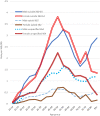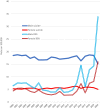Unanticipated Changes in Drug Overdose Death Rates in Canada During the Opioid Crisis
- PMID: 36248265
- PMCID: PMC9550153
- DOI: 10.1007/s11469-022-00932-9
Unanticipated Changes in Drug Overdose Death Rates in Canada During the Opioid Crisis
Abstract
Escalating drug overdose death rates in Canada are of ever-increasing concern. To better understand the extent of this health threat, we obtained mortality statistics and population figures for the years 2000 to 2020, and examined rates of overdose deaths, coded (using ICD-10) as accidental, suicide or "undetermined intent." The drug deemed as primarily responsible for the death was categorized as opioid, non-opioid, or unspecified. Age patterns of drug deaths were graphed. Joinpoint analysis was used to test the significance of changes in death rates. Accidental opioid and stimulant overdose death rates in Canada have climbed faster since 2011, though not as high as corresponding US rates. Unknown cause death rates have increased. However, opioid and non-opioid suicide rates have decreased significantly since 2011, and there have been fewer drug deaths of undetermined intent. Increased attention to the possibility that some suicides are being misclassified is warranted.
Keywords: Accidental poisoning; Canada; Mortality rates; Opioid crisis; Overdose deaths; Suicide.
© The Author(s) 2022.
Conflict of interest statement
Conflict of InterestThe authors declare no competing interests.
Figures








References
-
- Centers for Disease Control and Prevention (2019). Annual surveillance report of drug-related risks and outcomes – United States, 2017. Surveillance Report 1. https://www.cdc.gov/drugoverdose/pdf/pubs/2017-cdc-drug-surveillance-rep... Accessed August 10, 2022.
-
- Centers for Disease Control and Prevention (2022). Death Rate Maps & Graphs. www.cdc.gov/drugoverdose/deaths Accessed August 10, 2022.
LinkOut - more resources
Full Text Sources
